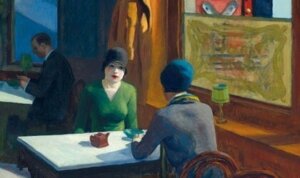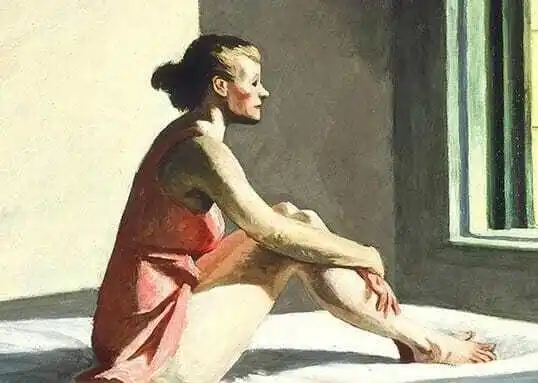Edward Hopper, the Realist Painter Who Inspired Hitchcock


Written and verified by the psychologist Valeria Sabater
Few artists immortalized the zeitgeist like American painter Edward Hopper, just as Hitchcock’s films evoked it. Zeitgeist is a concept from 18th- to 19th-century German philosophy, that means “spirit of the age”.
In etchings and watercolors, though most notably in his oil paintings, Edward Hopper inspired many. His genius works present cinematic renderings of a nation in the midst of seismic transition.
He tended to focus on the built environment. Particularly, when it offered a stark contrast between quaint nostalgia and shimmering modernity. Hopper’s ability to capture mood among people is what makes his work unique.
It strongly connects it to the optimism and alienation of Pre and Post War America. Edward Hopper was born in the rural setting of Nyack in upstate New York in 1882.
He began his artistic journey as an illustrator, precociously gifted and painfully introverted. In his later teens, he enrolled at the New York School of the Arts. During his school years, he transitioned to watercolors and oils under the tutelage of Merritt Chase and Robert Henri.
Chase and Henri were both leading Impressionist painters of the day. They instilled realism and a focus on the unsentimental in Hopper’s work.
Several trips to Paris followed, which opened Hopper’s eyes to the great French Impressionists. Upon returning, he regarded the “crude” and “depressive” quality of life in a rapidly developing New York City.
These formative years are incredibly important. After all, Hopper always maintained that his paintings reflected a very personal, and sometimes imagined, experience of the world.
“Great art is the outward expression of an inner life of the artist. And, this innerlife will result in his personal vision of the world.”
–Edward Hopper-

Edward Hopper’s best-known works
In this context, the sad and solitary figures that occupied his best-known works take on a deeper psychological weight. For example, Nighthawks, Intermission, Chop Suey and Eleven A.M., and House by The Railroad.
The famous masterpiece, House by the Railroad, was the first work acquired by the Museum of Modern Art (MoMA). This prestigious museum had only recently been opened in New York City for general viewing back then.
Hopper was certainly caught in the early onset of modernity, with its promises of prosperity and progress. The adrift characters in his paintings embody paradoxical feelings of loneliness and unease.
Almost always pictured in threshold spaces, neither domestic nor public, Hopper’s choice of setting was intriguing. It further adds to the obvious sense of alienation. On the one hand, these paintings are set-like representations of the archetypal American vernacular.
Some choices include gas stations, diners, motels, and movie theatres. Even so, arguably their greatest potency derives from the way in which Hopper used these quotidian settings. He perfectly transplanted them into his own mental state within them.
Seen this way, Hopper’s signature brand of noir emanates from the anthropomorphic qualities of his paintings. The lonely midnight diners, the stoic lighthouse, the waking storefronts, and shy street corners.
The widespread adoption of Hopper’s visual language within cinema
The key to the emotive power of these paintings is Hopper’s impressive use of light. This was greatly influenced by the tension and drama of Rembrandt and Degas.
Hopper’s paintings frequently use equally dramatic compositions of light and dark, adding to their strong sense of narrative. It surely explains the widespread adoption of his visual language within cinema.
Especially, by Alfred Hitchcock, Michelangelo Antonini, and David Lynch. For Hitchcock in particular, Hopper’s gaze was like a petri dish.
From this petri dish, an infinite number of possible narratives could grow. Evidence of Hopper’s influence can be found throughout Hitchcock’s oeuvre, though specifically his 1954 classic film Rear Window.
The power of Hopper’s paintings lies in what he chooses to exclude, and the tension and spectacle in Hitchcock’s Rear Window relies on what’s obscured or unseen.
For example, compare the parallels between Hopper’s 1928 painting Night Window, and the film’s character of Miss Lonelyhearts. Both frame solitary, partially nude women within the privacy of their own bedrooms, and both carry a sense of intrusion.
Most importantly, they carry a prevailing sense of social isolation in spite of their dense urban surroundings. Hopper’s 1926 painting Eleven A.M. also brilliantly showcases a solitary nude woman in her own bedroom.
“Maybe I’m not very human. What I wanted to do was to paint sunlight on the side of a house.”
-Edward Hopper-

Automat, 1927
If a single work could sum up Hopper’s evocative use of light, it might well be Automat. This painting also perfectly evokes his cinematic sense of narrative and unflinching portrayal of urban isolation.
In the painting, we see a solitary woman sitting at a table, staring into her cup of coffee. She has an air of quiet despair. Sitting under sterile lights (reflected as hanging orbs in the black window behind her), with impersonal furniture surrounding her.
She appears lost and adrift in unwelcoming surroundings. From the single glove she wears to her clothing, make-up, body language, and facial expression, this painting intrigued many.
With its rich sense of character, Hopper’s piece invited endless speculation and interpretation for centuries. The choice of an Automat is clearly no coincidence. This ‘automatic restaurant’ became widespread in New York from 1912.
Furthermore, like a walk-in vending machine made any need for human contact redundant. The ‘automatic restaurant’ ‘serves’ thousands of customers a day with industrial efficiency. This would doubtless have contributed to Hopper’s view of a social fabric under threat.
It was slowly eroded by the atomizing effects of modernity. Like Édouard Manet’s The Plum, also known as Plum Brandy, Automat keeps serving as a powerful symbol of depression. Similar to Edgar Degas’s L’Absinthe or Glass of Absinthe, it portrays modern cities’ lonely crowd paradox.
Later work
Later in his career, many of his works were displayed in various exhibits, namely at the Whitney Museum. This museum was located in New York City. The 1940s was a period in which he found the most commercial success.
Soon after, and even during this time period, he began losing critical favors. This was mainly due to the new art forms and that abstract pieces were beginning to enter the art world.
This took over the work he did, as well as the work of many famous artists before him. Did you know that Edward Hopper always returned to several motifs? For instance, the themes of the tensions between individuals.
He also painted about the conflict between tradition and progress in both rural and urban settings.
Artists always returned to their beloved themes. Van Gogh painted his sunflowers and Monet his water lilies. His choices of subject matter, particularly the places he painted, seem to have been somewhat unpredictable.
They were part of his constant battle with the chronic boredom that often stifled his urge to paint. This is what kept Hopper on the move.
Legacy
Today, art historians consider Edward Hopper the most prominent American impressionist, along with Winslow Homer. In the 1940s and 1950s, Hopper found himself losing critical favor in the wake of Abstract Expressionism. A new vanguard art movement emerged in the early 1940s.
Willem de Kooning, Jackson Pollock, and Mark Rothko broke away from accepted conventions in both technique and subject matter. Thus, they made monumentally scaled works. They stood as reflections of their individual psyches and tried to tap into universal inner sources.
Edward Hopper painted the feeling familiar to most humans: the sadness embedded in existence, in our intimate knowledge of the solitude of the self. The 20th century was the heyday of Sigmund Freud and Freudian Psychoanalysis.
If Hopper felt his psyche was distorted, he didn’t want it corrected. He didn’t want to tamper with his subconscious nor his personal vision of the world.
Along with Georgia O’Keeffe, Edward Hopper holds an exceptional status. They’re two of the most prominent figures in early 20th century American art. However, Hopper never lacked popular appeal.
By the time of his death in 1967, Hopper was considered a major influence by realist artists. There was a new generation of American realist artists.
“I believe that the great painters with their intellect as master have attempted to force this unwilling medium of paint and canvas into a record of their emotions.”
-Edward Hopper-
All cited sources were thoroughly reviewed by our team to ensure their quality, reliability, currency, and validity. The bibliography of this article was considered reliable and of academic or scientific accuracy.
- Levin, Gail (2007) Edward Hopper: An Intimate Biography. Rizzoli
- Nochlin, L. (1981). Edward Hopper y las imágenes de la alienación. Art Journal , 41 (2), 136-141. https://doi.org/10.1080/00043249.1981.10792460
This text is provided for informational purposes only and does not replace consultation with a professional. If in doubt, consult your specialist.








